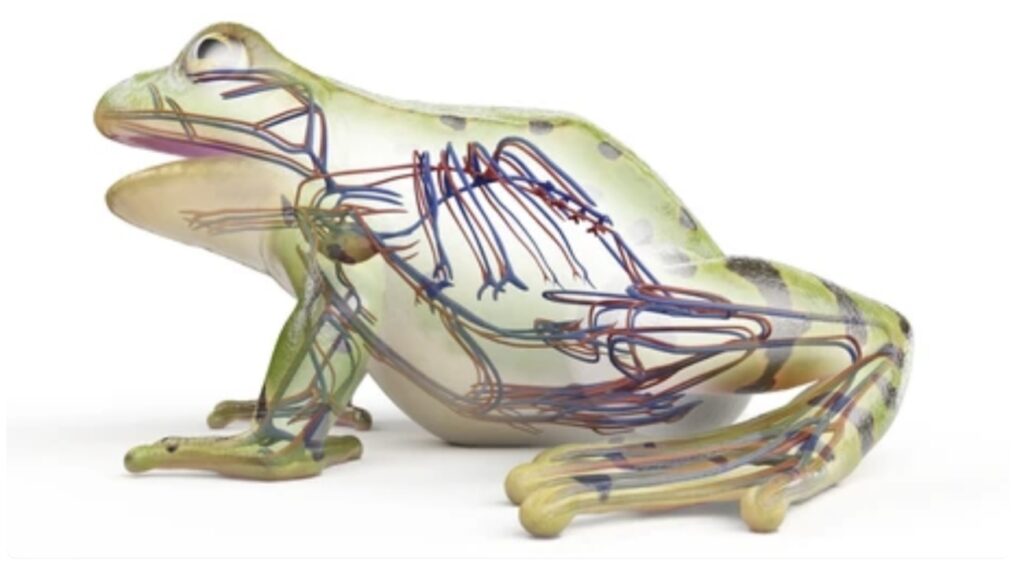INTRODUCTION
The circulatory system of amphibians, a class of vertebrates that includes frogs, toads, salamanders, and newts, is adapted for their unique dual life in both aquatic and terrestrial environments. This system ensures efficient transport of oxygen, nutrients, and waste products throughout their bodies, allowing them to thrive in diverse habitats ranging from ponds and streams to forests and grasslands. In this exploration, we will delve into the anatomy, function, adaptations, and unique features of the circulatory system in amphibians.
ANATOMY OF THE CIRCULATORY SYSTEM
HEART

Amphibians have a three-chambered heart consisting of two atria and one ventricle. This structure allows for some separation of oxygenated and deoxygenated blood, although there is partial mixing in the ventricle. The ventricle pumps blood to both the lungs (or skin) and the rest of the body.
BLOOD VESSELS

Amphibians possess a closed circulatory system, where blood flows through vessels and does not directly bathe the organs. The main blood vessels include:
Arteries: Carry oxygenated blood away from the heart to various parts of the body.
Veins: Return deoxygenated blood back to the heart.
Capillaries: Microscopic vessels where exchange of gases, nutrients, and waste products occurs between the blood and tissues.
FUNCTION OF THE CIRCULATORY SYSTEM
OXYGEN TRANSPORT
The primary function of the circulatory system in amphibians is to transport oxygen from the environment (either water or air) to the tissues and organs. Amphibians can exchange gases through their skin, lungs, or gills, depending on the species and life stage. Blood picks up oxygen from these respiratory surfaces and delivers it to cells throughout the body.
NUTRIENT TRANSPORT
In addition to oxygen, the circulatory system transports nutrients absorbed from the digestive system to all parts of the body. These nutrients are essential for cellular functions and overall metabolism.
WASTE REMOVAL
Metabolic waste products, such as carbon dioxide and nitrogenous wastes, are transported by the circulatory system to the respiratory surfaces (lungs, skin, or gills) for elimination. This process helps maintain proper pH balance and prevents toxic buildup in the amphibian’s body.
HORMONES DISTRIBUTION
Hormones produced by various organs are carried through the bloodstream to target tissues, where they regulate processes such as growth, reproduction, and metabolism.
ADAPTATION AND UNIQUE FEATURES
CUTANEOUS RESPIRATION
Many amphibians rely on cutaneous (skin) respiration, especially during their larval stage or when in moist environments. Their skin is highly vascularized, allowing for gas exchange to occur directly through the skin. This adaptation is particularly important in species like frogs and salamanders, which spend much of their time in water or humid environments.
PULMONARY RESPIRATION
Adult amphibians typically have lungs for breathing air when they are on land. The pulmonary circuit of their circulatory system transports blood to and from the lungs, facilitating the exchange of oxygen and carbon dioxide. Some amphibians, like frogs, breathe through both their lungs and their skin, depending on environmental conditions.
CUTANEOUS DRINKING
Certain amphibians, especially those in arid environments or during droughts, can absorb water directly through their skin. The circulatory system plays a role in transporting absorbed water to maintain hydration and proper bodily functions.
CARDIAC ADAPTATIONS
The three-chambered heart of amphibians allows for some separation of oxygen-rich and oxygen-poor blood, improving efficiency compared to fish but not as efficiently as mammals and birds with a four-chambered heart. This adaptation helps support their varying respiratory modes and physiological needs in different environments.
CHALLENGES AND RESPONSES
TEMPERATURE REGULATION
Amphibians are ectothermic (cold-blooded), meaning they rely on external sources of heat to regulate their body temperature. Their circulatory system plays a role in distributing heat throughout the body, affecting metabolic rates and activity levels.
ENVIRONMENTAL CHANGES
Amphibians are highly sensitive to environmental changes, including pollutants, habitat loss, and climate change. These factors can impact their circulatory system’s ability to function properly, affecting overall health and survival.
CONCLUSION
The circulatory system of amphibians is a testament to their evolutionary adaptability to diverse habitats and ecological niches. Through specialized organs, such as their three-chambered heart and highly vascularized skin, amphibians efficiently transport oxygen, nutrients, and waste products, enabling them to thrive in aquatic and terrestrial environments. Understanding the intricacies of their circulatory system provides insights into the remarkable adaptations that have allowed amphibians to successfully colonize a wide range of habitats across the globe.
Discover more from ZOOLOGYTALKS
Subscribe to get the latest posts sent to your email.


